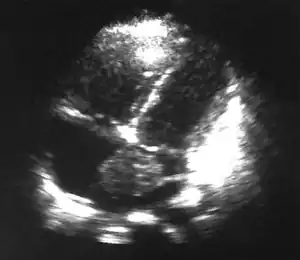Obstructive shock
| Obstructive shock | |
|---|---|
| Other names: Mechanical shock[1] | |
| Video explanation of shock | |
| Specialty | Emergency medicine |
| Symptoms | Confusion, cool arms and legs, weak pulses[2] |
| Complications | Multiple organ dysfunction syndrome[2] |
| Usual onset | Rapid[3] |
| Causes | Pulmonary embolism, cardiac tamponade, tension pneumothorax[1] |
| Differential diagnosis | Cardiogenic shock[4] |
| Treatment | Based on underlying cause[3] |
| Frequency | Relatively uncommon[3] |
Obstructive shock is a form of shock due to physical obstruction of the filling or emptying of the heart.[2] This results in not enough blood flow to body tissues.[3] Symptoms may include confusion, cool arms and legs, fast heart rate and weak pulses.[2] Onset is generally very rapid.[3] Complications may include multiple organ dysfunction syndrome.[2]
Causes include pulmonary embolism, cardiac tamponade, tension pneumothorax, and atrial tumors.[1][2] Obstructive shock presents similar to and is sometimes grouped together with cardiogenic shock.[2][4][3] Diagnosis is generally based on symptoms and examination.[2] However, multiple forms of shock may present together.[3]
Treatment depends on the underlying cause.[2] Cardiac tamponade may be treated with pericardiocentesis; tension pneumothorax with needle decompression or chest tube; and pulmonary embolism with thrombolysis and anticoagulation, or a surgical embolectomy.[2] Obstructive shock makes up less than 2% of cases of shock in the intensive care unit.[5][3]
Signs and symptoms
Symptoms may include confusion, cool arms and legs, fast heart rate and weak pulses.[2] Onset is generally very rapid.[3]
Causes
- Cardiac tamponade
- Constrictive pericarditis (late stage)
- Aortic stenosis
- Tension pneumothorax
- Massive pulmonary embolism
- Anterior mediastinal mass
Diagnosis

In obstructive shock, CO is decreased, CVP is elevated, SVR is increased, and PAOP is increased which is similar to cardiogenic shock. Obstructive shock can most easily be differentiated from cardiogenic shock by considering the greater clinical picture in the context of the PA catheter data (or echocardiography)
Treatment
Treatment depends on the underlying cause.[2] Cardiac tamponade may be treated with pericardiocentesis; tension pneumothorax with needle decompression or chest tube; and pulmonary embolism with thrombolysis and anticoagulation, or a surgical embolectomy.[2]
References
- 1 2 3 International Trauma Life Support for Emergency Care Providers (8 ed.). Pearson Education Limited. 2018. p. 175. ISBN 978-1292-17084-8.
- 1 2 3 4 5 6 7 8 9 10 11 12 13 "Shock - Critical Care Medicine". Merck Manuals Professional Edition. Archived from the original on 27 November 2020. Retrieved 5 January 2021.
- 1 2 3 4 5 6 7 8 9 Standl, T; Annecke, T; Cascorbi, I; Heller, AR; Sabashnikov, A; Teske, W (9 November 2018). "The Nomenclature, Definition and Distinction of Types of Shock". Deutsches Arzteblatt international. 115 (45): 757–768. doi:10.3238/arztebl.2018.0757. PMID 30573009.
- 1 2 Kosaraju, A; Pendela, VS; Hai, O (January 2020). "Cardiogenic Shock". PMID 29489148.
{{cite journal}}: Cite journal requires|journal=(help) - ↑ McEvoy, Matthew D.; Furse, Cory M. (2017). Advanced Perioperative Crisis Management. Oxford University Press. p. 67. ISBN 978-0-19-022645-9. Archived from the original on 2021-08-28. Retrieved 2021-01-05.